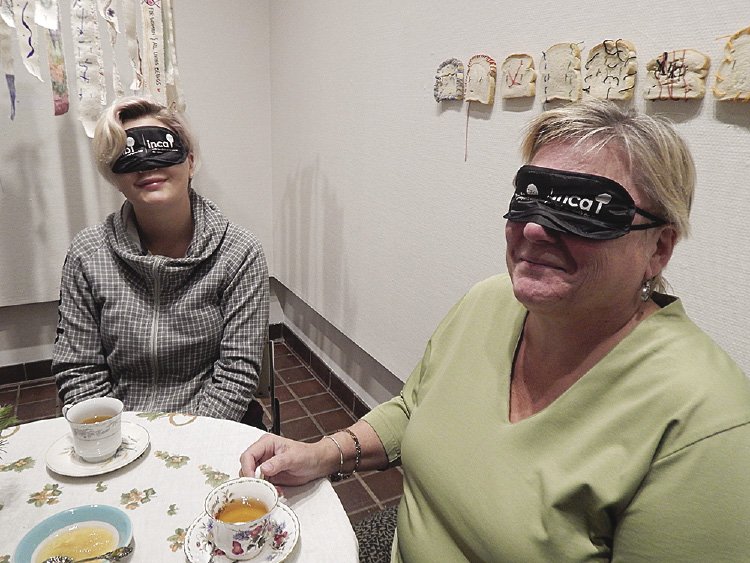The room is in semi darkness, as the winter night deepens. Some of the people in the room are wearing specialized eyewear that replicates visual impairment. Those people do so by choice—others do not need the eyewear. In varying degrees, they are blind. The sighted ones are present to hear the stories of those who are blind. And not only blind—
“The First Nations Support Group came up with the idea of a theatre project,” says Willow Springs Creative Centre coordinator Judy Vinni, who, along with playwright Eleanor Albanese, artist Jen LaFrance, and sound artist Zoe Gordon worked with the Group under the auspices of the Thunder Bay chapter of the Canadian National Institute for the Blind (CNIB). “They thought it was a bold idea to use a visual form of art to share their stories of vision loss.”
In the darkened room, the recorded voice of Indigenous film maker Michelle Desrosiers begins gently reciting the traditional Algonquin tale of The Rough-Faced Girl. It is a story like the more familiar Cinderella, of a young woman of pure heart who is abused by her step-sisters. They desire to have the Invisible One, a great and powerful hunter, as their husband. In pauses as the story enfolds, the First Nations story tellers present in the darkened room quietly share their experiences of blindness.
As Vinni and LaFrance worked over the ensuing months with the Group, the project evolved from a theatre piece into an interactive audio presentation. The Group chose The Bii Zii Dun Goo Ko’Hoo (Listening Owl) Project as the event name and gave input into the design of the event’s logo. The Group also commissioned local Indigenous artist Perry Perrault to create a representative painting for the Listening Owl evening.
Some of the stories are fraught. One Indigenous woman speaks of being sexually assaulted during an eye examination. Another relates how his doctor was in tears, telling him, “I can’t do anything for you!” A third speaks of verbal abuse by a city bus driver. Some leave their white canes at home, to avoid being targeted by bullies. Yet others spin their stories in humour. One woman tells of having a one-sided conversation with a bear, before she realized that she wasn’t addressing a human.
“I always think everything is funny,” says Wilfred Moonias. “My late wife said, ‘Why don’t you use that humour to help you in your blindness’, so I did!”
“We held regular sharing sessions at the CNIB office (over the months),” says Vinni. “Eleanor Albanese used dramatic techniques and prompts that participants could smell, hear, taste and feel to help draw out the multitude of stories each project participant had to share.”
The Rough-Faced Girl, disfigured by torture and by tending the fires to keep everyone warm, hears how each of the sisters fail the test of their suitability to be the Invisible One’s wife. The Rough-Face Girl realizes that she can see the Invisible One and asks if she may take the test. To the scorn and amazement of her tormentors, she is accepted.
“In my dreams, everything is colourful,” says Ma-Nee Chacaby. “I can see a number of senses roused. There’s a hidden gift in disability—it will come out and help you. When you don’t see, you got to believe in something to guide you through.”
Participants in the When I’m Dreaming evening sit around tables, listening to the stories over an ethereal soundscape. Tea, blueberry jam and bannock are available at every table, for a “kitchen table” atmosphere. Sensory stimulants like sprigs of cedar and fir, spruce and pine cones, and rocks are left in bowls in the centre of each table for anyone to touch and feel. Each table also has a storyteller, to answer any questions.
Sighted audience member Laurie Kendall marvels at the courage and strength of the Group members: “Some of those stories were horrifying!”
Other participants speak of relatives blind or becoming so, and their anguish as a result. Sighted participants are also given a short talk on how to approach and assist with people with vision loss (e.g: “Never tell a blind person something is ‘over there!’”), and, if one is present, how to interact with a guide dog.
The Rough-Faced Girl, embodying the Indigenous virtues of honesty, courage and respect, answers every question, and is rewarded with marriage to the Invisible One.
The evening draws to a close and the lights come up. Hopefully, those sighted ones have had their eyes opened to the reality of those who lack sight.
When I’m Dreaming, I’m not Blind: The Listening Owl Theatre Project took place November 28, 2019 at The Art Gallery, Thunder Bay.




